Thermodynamic Efficiency Gains and their Role as a Key ‘Engine of Economic Growth’
Abstract
:1. Introduction
2. Materials and Methods
2.1. Model Construction
2.2. MARCO-UK Equations
2.3. Data and Estimation Process
2.4. Basefit Model and Validation
2.5. Counterfactual (ex-post) Simulations
- Thermodynamic efficiency (final-to-useful energy conversion efficiency);
- Final energy use (total, i.e., sum of Households, Industry, and Other sectors);
- Useful exergy (total);
- Energy prices (paid by Households, Industry, and Other sectors);
- Investment in fixed capital (annual); and
- Labour (number of employed people).
3. Results: Thermodynamic Efficiency Gains Revealed as a Key ‘Engine of Economic Growth’
3.1. Simulation Results
3.2. The Strong Role(s) of Energy in Economic Growth
3.3. The Divergent Influences of Capital and Labour
4. Discussion: The ‘Efficiency-led Growth Engine’ Mechanism
5. Conclusions
5.1. The Underrecognised Role of Energy
5.2. Energy Efficiency as a Good Return on Investment
5.3. Developing Thermodynamically-Consistent Modelling
5.4. The Decoupling Challenge
Supplementary Materials
Author Contributions
Funding
Acknowledgments
Conflicts of Interest
References
- European Parliament. Directive 2012/27/EU of the European Parliament and of the Council of 25 October 2012 on energy efficiency. Off. J. Eur. Union Dir. 2012, 315, 1–56. [Google Scholar] [CrossRef]
- An-gang, H.U. The Five-Year Plan: A new tool for energy saving and emissions reduction in China. Adv. Clim. Change Res. 2017, 7, 222–228. [Google Scholar] [CrossRef]
- Geller, H.; Harrington, P.; Rosenfeld, A.H.; Tanishima, S.; Unander, F. Polices for increasing energy efficiency: Thirty years of experience in OECD countries. Energy Policy 2006, 34, 556–573. [Google Scholar] [CrossRef]
- International Energy Agency (IEA). Energy Efficiency—Market Report 2016. Available online: https://www.iea.org/eemr16/files/medium-term-energy-efficiency-2016_web.pdf (accessed on 26 December 2018).
- Meinshausen, M.; Meinshausen, N.; Hare, W.; Raper, S.C.B.; Frieler, K.; Knutti, R.; Frame, D.J.; Allen, M.R. Greenhouse-gas emission targets for limiting global warming to 2 °C. Nature 2009, 458, 1158–1162. [Google Scholar] [CrossRef] [PubMed] [Green Version]
- Herring, H. Does energy efficiency save energy? The debate and its consequences. Appl. Energy 1999, 63, 209–226. [Google Scholar] [CrossRef]
- Sorrell, S. Energy Substitution, Technical Change and Rebound Effects. Energies 2014, 7, 2850–2873. [Google Scholar] [CrossRef] [Green Version]
- Schipper, L.; Grubb, M. On the rebound? Feedback between energy intensities and energy uses in IEA countries. Energy Policy 2000, 28, 367–388. [Google Scholar] [CrossRef]
- Gillingham, K.; Kotchen, M.J.; Rapson, D.S.; Wagner, G. Energy policy: The rebound effect is overplayed. Nature 2013, 493, 475–476. [Google Scholar] [CrossRef]
- Ayres, R.U.; Warr, B. The Economic Growth Engine: How Energy and Work Drive Material Prosperity; Edward Elgar: Cheltenham, UK, 2010. [Google Scholar]
- McKinsey & Company. Energy Efficiency: A Compelling Global Resource. 2010, pp. 1–74. Available online: https://www.mckinsey.com/~/media/mckinsey/dotcom/client_service/Sustainability/PDFs/A_Compelling_Global_Resource.ashx (accessed on 26 December 2018).
- International Energy Agency (IEA). Capturing the Multiple Benefits of Energy Efficiency. Available online: https://www.iea.org/publications/freepublications/publication/captur_the_multiplbenef_ofenergyeficiency.pdf (accessed on 26 December 2018).
- Patterson, M.G. What is energy efficiency? Energy Policy 1996, 24, 377–390. [Google Scholar] [CrossRef]
- Madlener, R.; Alcott, B. Energy rebound and economic growth: A review of the main issues and research needs. Energy 2009, 34, 370–376. [Google Scholar] [CrossRef]
- Koesler, S.; Swales, K.; Turner, K. International spillover and rebound effects from increased energy efficiency in Germany. Energy Econ. 2016, 54, 444–452. [Google Scholar] [CrossRef] [Green Version]
- Bataille, C.; Melton, N. Energy efficiency and economic growth: A retrospective CGE analysis for Canada from 2002 to 2012. Energy Econ. 2017, 64, 118–130. [Google Scholar] [CrossRef]
- Kasahara, S.; Paltsev, S.; Reilly, J.; Jacoby, H.; Ellerman, A.D. Climate change taxes and energy efficiency in Japan. Environ. Resour. Econ. 2007, 37, 377–410. [Google Scholar] [CrossRef]
- Barker, T.; Dagoumas, A.; Rubin, J. The macroeconomic rebound effect and the world economy. Energy Effic. 2009, 2, 411–427. [Google Scholar] [CrossRef]
- E3ME Technical Manual; Version 6; Cambridge Econometrics: Cambridge, UK, 2014.
- Sijm, J.; Lehmann, P.; Chewpreecha, U.; Gawel, E.; Mercure, J.-F.; Pollitt, H.; Strunz, S. EU Climate and Energy Policy beyond 2020: Are Additional Targets and Instruments for Renewables Economically Reasonable? UFZ Discuss Pap No 3/2014. 2014, pp. 1–36. Available online: http://hdl.handle.net/10419/103564 (accessed on 26 December 2018).
- Ertesvåg, I.S. Society exergy analysis: A comparison of different societies. Energy 2001, 26, 253–270. [Google Scholar] [CrossRef]
- Reistad, G. Available Energy Conversion and Utilization in the United States. ASME Trans. Ser. J. Eng. Power 1975, 97, 429–434. [Google Scholar] [CrossRef]
- Wall, G. Exergy conversion in the Swedish society. Resour. Energy 1987, 9, 55–73. [Google Scholar] [CrossRef] [Green Version]
- Sciubba, E. Beyond thermoeconomics? The concept of Extended Exergy Accounting and its application to the analysis and design of thermal systems. Exergy Int. J. 2001, 1, 68–84. [Google Scholar] [CrossRef]
- Serrenho, A.C.; Sousa, T.; Warr, B.; Ayres, R.U.; Domingos, T. Decomposition of useful work intensity: The EU (European Union)-15 countries from 1960 to 2009. Energy 2014, 76, 704–715. [Google Scholar] [CrossRef]
- Ayres, R.U.; Ayres, L.W.; Warr, B. Exergy, power and work in the US economy, 1900–1998. Energy 2003, 28, 219–273. [Google Scholar] [CrossRef]
- Serrenho, A.C.; Warr, B.; Sousa, T.; Ayres, R.U. Structure and dynamics of useful work along the agriculture-industry-services transition: Portugal from 1856 to 2009. Struct. Change Econ. Dyn. 2016, 36, 1–21. [Google Scholar] [CrossRef] [Green Version]
- Technical Aspects of the More Efficient Utilization of Energy: Chapter 2—Second law efficiency: The Role of the Second Law of Thermodynamics in Assessing the Efficiency of Energy Use. Available online: https://aip.scitation.org/doi/pdf/10.1063/1.30306 (accessed on 26 December 2018).
- American Physical Society. Energy Future: Think Efficiency 2008. Available online: http://www.aps.org/energyefficiencyreport/index.cfm (accessed on 29 December 2018).
- Brockway, P.E.; Steinberger, J.K.; Barrett, J.R.; Foxon, T.J. Understanding China’s past and future energy demand: An exergy efficiency and decomposition analysis. Appl. Energy 2015, 155, 892–903. [Google Scholar] [CrossRef]
- International Energy Agency (IEA). Worldwide Trends in Energy Use and Efficiency: Key Insights from IEA Indicator Analysis 2008; IEA: Paris, France, 2008. [Google Scholar]
- Liddle, B. OECD energy intensity: Measures, trends, and convergence. Energy Effic. 2012, 5, 583–597. [Google Scholar] [CrossRef]
- Klein, L.R. Economic Fluctuations in the United States, 1921–1941, 1st ed.; John Wiley and Sons Ltd.: London, UK, 1950. [Google Scholar]
- Lavoie, M. Post-Keynesian Economics: New Foundations; Edward Elgar: Cheltenham, UK, 2014. [Google Scholar]
- King, C.W. Comparing World Economic and Net Energy Metrics, Part 3: Macroeconomic Historical and Future Perspectives. Energies 2015, 8, 12997–13020. [Google Scholar] [CrossRef] [Green Version]
- Kümmel, R. Why energy’s economic weight is much larger than its cost share. Environ. Innov. Soc. Transit. 2013, 9, 33–37. [Google Scholar] [CrossRef]
- Santos, J.; Domingos, T.; Sousa, T.; St. Aubyn, M. Useful Exergy Is Key in Obtaining Plausible Aggregate Production Functions and Recognizing the Role of Energy in Economic Growth: Portugal 1960–2009. Ecol. Econ. 2018, 148, 103–120. [Google Scholar] [CrossRef]
- Guevara, Z.; Sousa, T.; Domingos, T. Insights on Energy Transitions in Mexico from the Analysis of Useful Exergy 1971–2009. Energies 2016, 9, 488. [Google Scholar] [CrossRef]
- Warr, B.; Ayres, R. REXS: A forecasting model for assessing the impact of natural resource consumption and technological change on economic growth. Struct. Change Econ. Dyn. 2006, 17, 329–378. [Google Scholar] [CrossRef]
- Hall, L.M.H.; Buckley, A.R. A review of energy systems models in the UK: Prevalent usage and categorisation. Appl. Energy 2016, 169, 607–628. [Google Scholar] [CrossRef]
- Zha, D.; Zhou, D. The elasticity of substitution and the way of nesting CES production function with emphasis on energy input. Appl. Energy 2014, 130, 793–798. [Google Scholar] [CrossRef]
- Brillet, J.L. Structural Econometric Modelling: Methodology and Tools with Applications under EViews 2016. Available online: http://www.eviews.com/StructModel/structmodel.pdf (accessed on 26 December 2018).
- Varga, R.S. Basic Iterative Methods and Comparison Theorems. In Matrix Iterative Analysis; Springer Series in Computational Mathematics; Springer: Berlin/Heidelberg, Germany, 2009; Volume 27, Available online: https://doi.org/10.1007/978-3-642-05156-2_3 (accessed on 26 December 2018).
- Allan, G.; Gilmartin, M.; Turner, K.; McGregor, P.; Swales, K. Review of Evidence for the Rebound Effect Technical Report 4: Computable General Equilibrium Modelling Studies. UKERC Work Pap UKERC/WP/TPA/2007/012. 2007. Available online: http://www.ukerc.ac.uk/publications/ukerc-review-of-evidence-for-the-rebound-effect-technical-report-4-computable-general-equilibrium-modelling-studies.html (accessed on 26 December 2018).
- Kander, A.; Stern, D.I. Economic growth and the transition from traditional to modern energy in Sweden. Energy Econ. 2014, 46, 56–65. [Google Scholar] [CrossRef] [Green Version]
- Ayres, R.U.; Warr, B. Accounting for growth: The role of physical work. Struct. Change Econ. Dyn. 2005, 16, 181–209. [Google Scholar] [CrossRef]
- Stresing, R.; Lindenberger, D.; Kümmel, R. Cointegration of output, capital, labor, and energy. Eur. Phys. J. B 2008, 66, 279–287. [Google Scholar] [CrossRef] [Green Version]
- Solow, R.M. Technical Change and the Aggregate Production Function. Rev. Econ. Stat. 1957, 39, 312–320. [Google Scholar] [CrossRef]
- Berndt, E.R. Energy use, technical progress and productivity growth: A survey of economic issues. J. Prod. Anal. 1990, 2, 67–83. [Google Scholar] [CrossRef] [Green Version]
- Turner, K.; Hanley, N. Energy efficiency, rebound effects and the environmental Kuznets Curve. Energy Econ. 2011, 33, 709–720. [Google Scholar] [CrossRef] [Green Version]
- Hulten, C.R.; Growth Accounting. Natl Bur Econ Res Work Pap 15341. Available online: www.nber.org/papers/w15341 (accessed on 26 December 2018).
- Schreyer, P. Capital Stocks, Capital Services and Multi-factor Productivity Measures. OECD Econ. Stud. 2004, 2003, 163–184. [Google Scholar] [CrossRef]
- Hannon, B.; Joyce, J. Energy and technical progress. Energy 1981, 6, 187–195. [Google Scholar] [CrossRef]
- Chitnis, M.; Sorrell, S.; Druckman, A.; Firth, S.K.; Jackson, T. Who rebounds most? Estimating direct and indirect rebound effects for different UK socioeconomic groups. Ecol. Econ. 2014, 106, 12–32. [Google Scholar] [CrossRef] [Green Version]
- Nel, W.P.; van Zyl, G. Defining limits: Energy constrained economic growth. Appl. Energy 2010, 87, 168–177. [Google Scholar] [CrossRef]
- Ayres, R.U.; Turton, H.; Casten, T. Energy efficiency, sustainability and economic growth. Energy 2007, 32, 634–648. [Google Scholar] [CrossRef]
- Berndt, E.R.; Wood, D.O. Technology, Prices and Derived Demand for Energy. Rev. Econ. Stud. Stat. 1975, 57, 259–268. [Google Scholar] [CrossRef]
- Stern, D.I. Elasticities of substitution and complementarity. J. Prod. Anal. 2011, 36, 79–89. [Google Scholar] [CrossRef]
- Ayres, R.U.; Voudouris, V. Introduction to: The enigma of economic growth: Beyond Solow-type macroeconomic perspectives. Energy Policy 2015, 86, 802–803. [Google Scholar] [CrossRef]
- Kümmel, R.; Ayres, R.U.; Lindenberger, D. Thermodynamic laws, economic methods and the productive power of energy. J. Non-Equilib. Thermodyn. 2010, 35, 145–179. [Google Scholar] [CrossRef]
- Warr, B.; Ayres, R.; Eisenmenger, N.; Krausmann, F.; Schandl, H. Energy use and economic development: A comparative analysis of useful work supply in Austria, Japan, the United Kingdom and the US during 100 years of economic growth. Ecol. Econ. 2010, 69, 1904–1917. [Google Scholar] [CrossRef]
- Voudouris, V.; Ayres, R.; Serrenho, A.C.; Kiose, D. The economic growth enigma revisited: The EU-15 since the 1970s. Energy Policy 2015, 86, 812–832. [Google Scholar] [CrossRef] [Green Version]
- Brockway, P.E.; Barrett, J.R.; Foxon, T.J.; Steinberger, J.K. Divergence of trends in US and UK aggregate exergy efficiencies 1960–2010. Environ. Sci. Technol. 2014, 48, 9874–9881. [Google Scholar] [CrossRef]
- O’Mahony, M.; Timmer, M.P. Output, input and productivity measures at the industry level: The EU KLEMS database. Econ. J. 2009, 119, 374–403. [Google Scholar] [CrossRef]
- van der Werf, E. Production functions for climate policy modeling: An empirical analysis. Energy Econ. 2008, 30, 2964–2979. [Google Scholar] [CrossRef] [Green Version]
- Mundaca, L.; Neij, L.; Worrell, E.; McNeil, M. Evaluating Energy Efficiency Policies with Energy-Economy Models. Annu. Rev. Environ. Resour. 2010, 35, 305–344. [Google Scholar] [CrossRef] [Green Version]
- Sharma, S.S. The relationship between energy and economic growth: Empirical evidence from 66 countries. Appl. Energy 2010, 87, 3565–3574. [Google Scholar] [CrossRef]
- Semieniuk, G. Fossil Energy in Economic Growth: A Study of the Energy Direction of Technical Change, 1950–2012. SPRU Work Pap Ser (SWPS), 2016-11. 2016, pp. 1–37. Available online: http://dx.doi.org/10.2139/ssrn.2795424 (accessed on 26 December 2018).
- Csereklyei, Z.; Stern, D.I. Global Energy Use: Decoupling or Convergence? Energy Econ. 2015, 51, 633–641. [Google Scholar] [CrossRef]
- Rosen, M.A. A Concise Review of Exergy-Based Economic Methods. In Proceedings of the 3rd IASME/WSEAS International Conference on Energy & Environment, Cambridge, UK, 23–25 February 2008; pp. 136–144. [Google Scholar]
- McGlade, C.; Ekins, P. The geographical distribution of fossil fuels unused when limiting global warming to 2’C. Nature 2015, 517, 187–190. [Google Scholar] [CrossRef] [PubMed]
- Bumpus, A.; Comello, S. Emerging clean energy technology investment trends. Nat. Clim. Change 2017, 7, 382–385. [Google Scholar] [CrossRef]
- Alcott, B. Impact caps: Why population, affluence and technology strategies should be abandoned. J. Clean. Prod. 2010, 18, 552–560. [Google Scholar] [CrossRef]
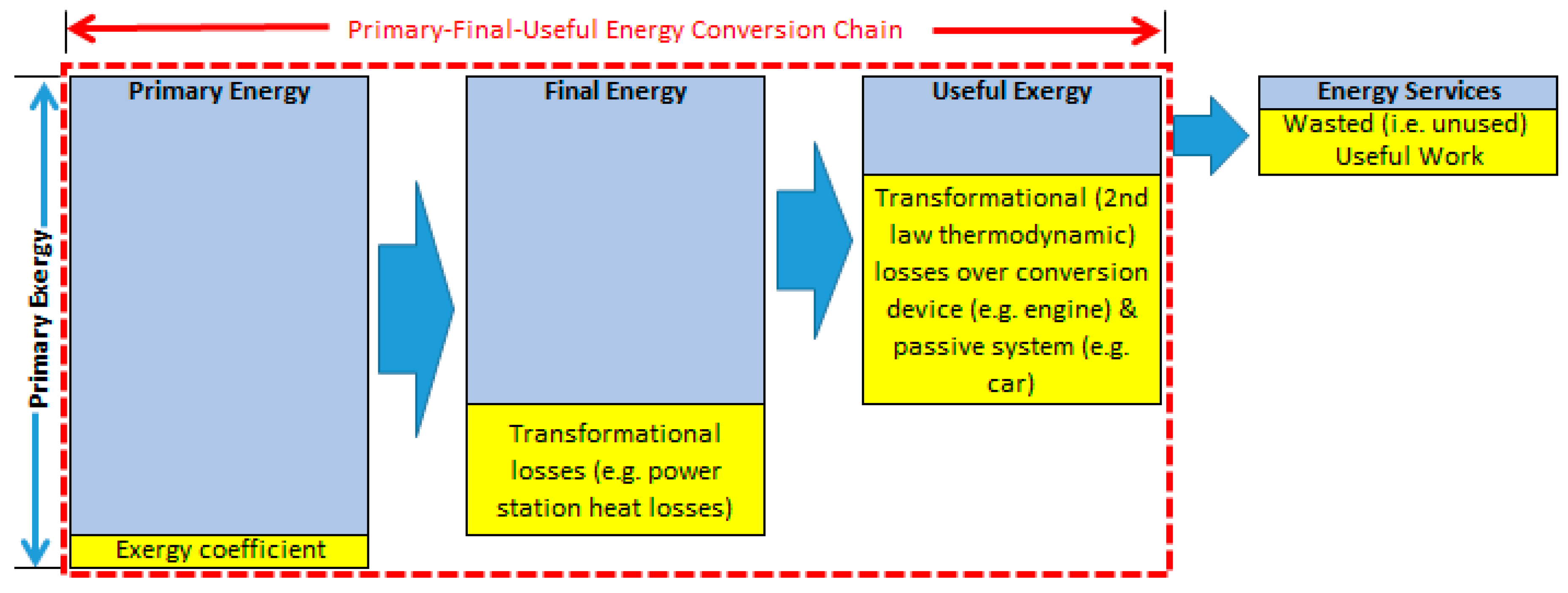
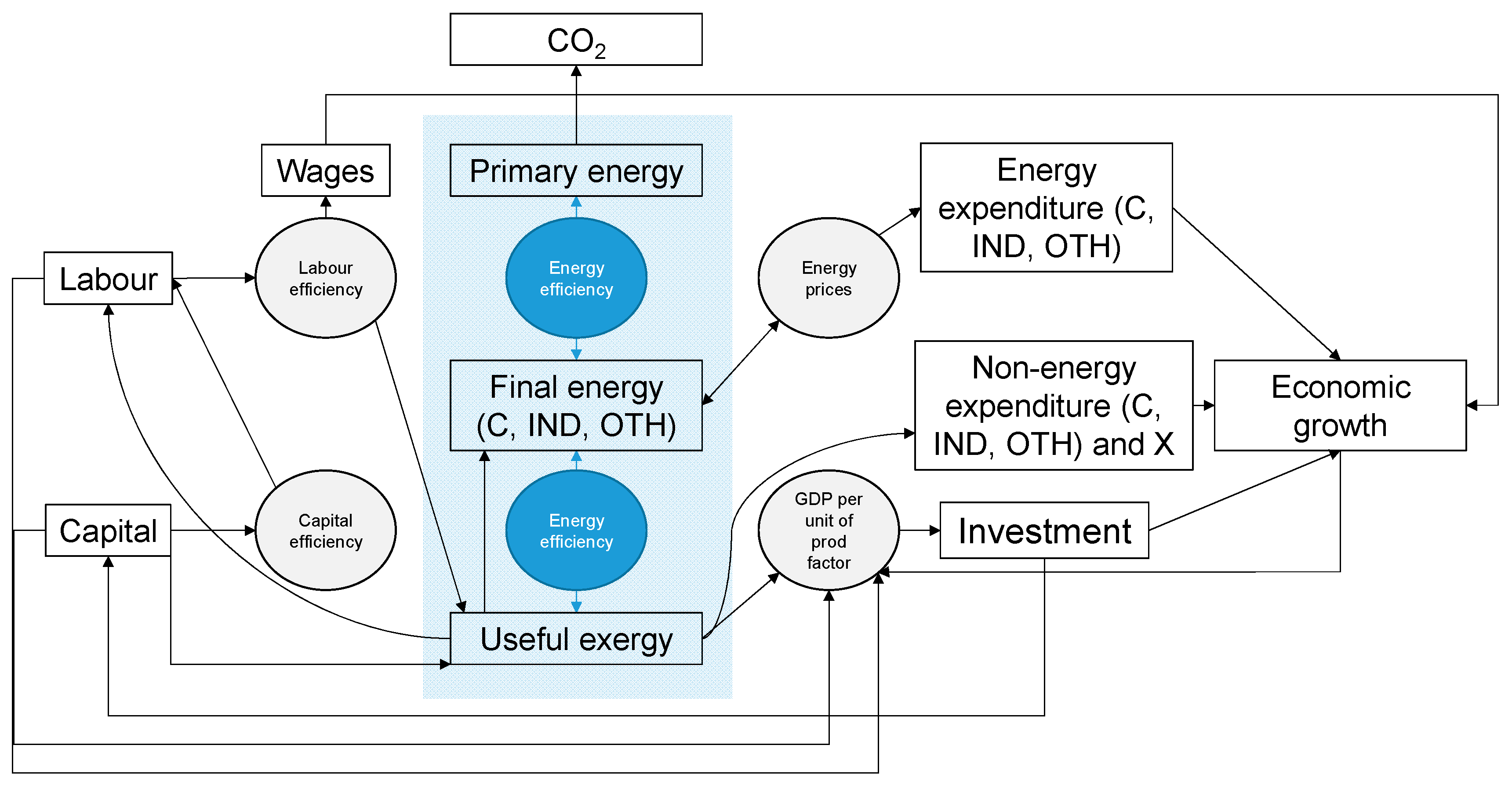
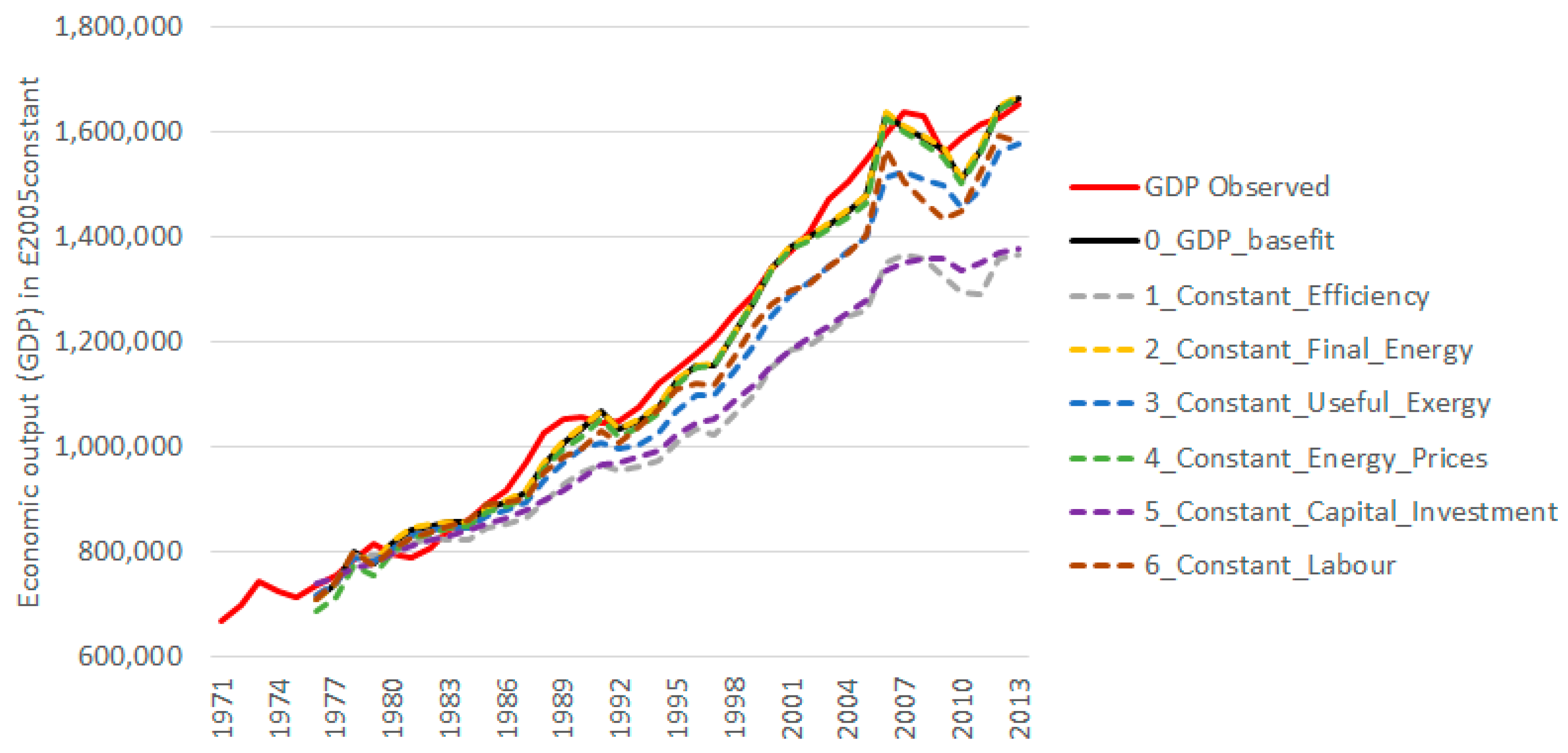
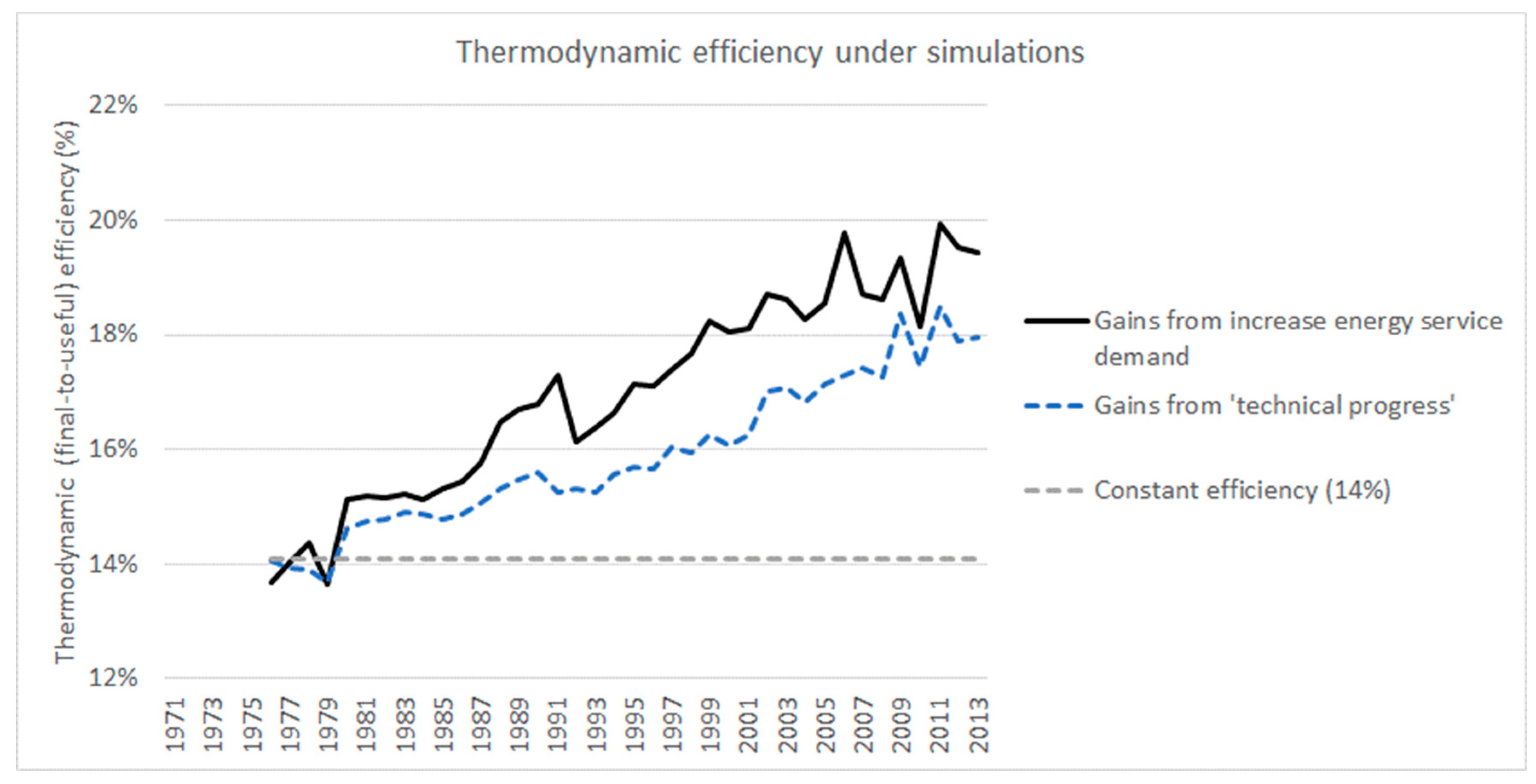
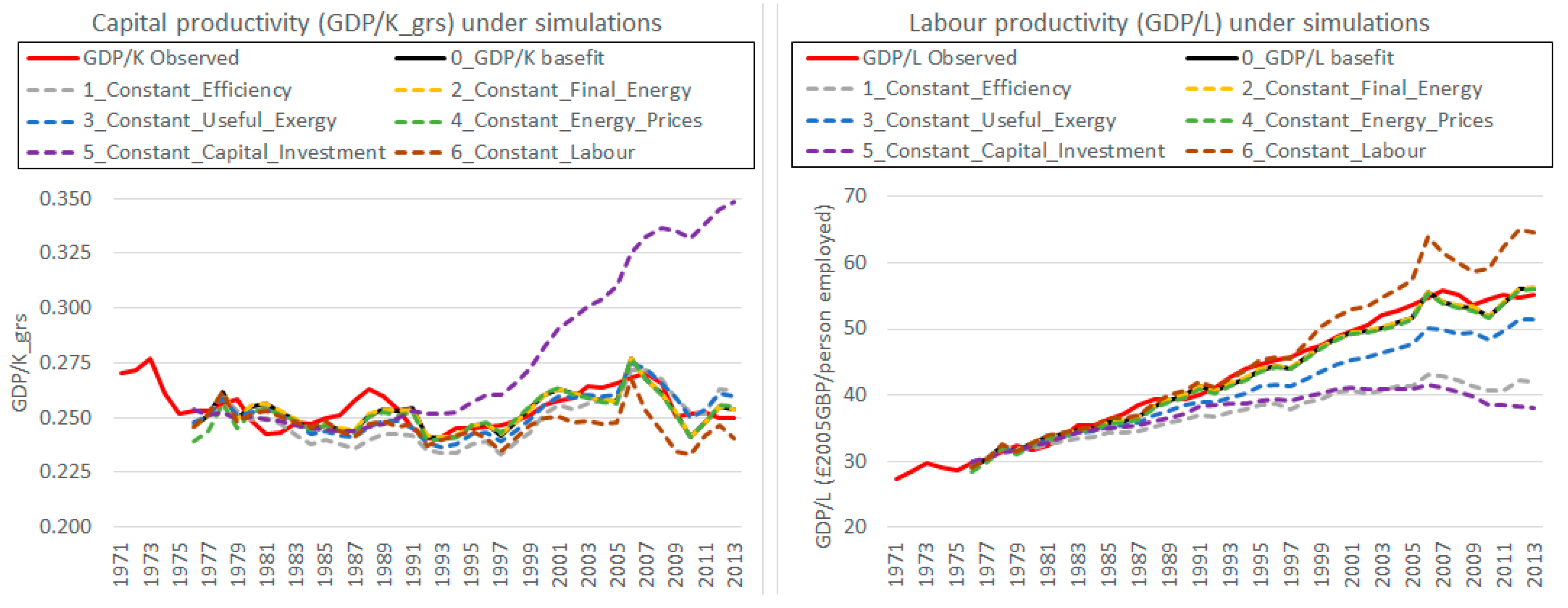
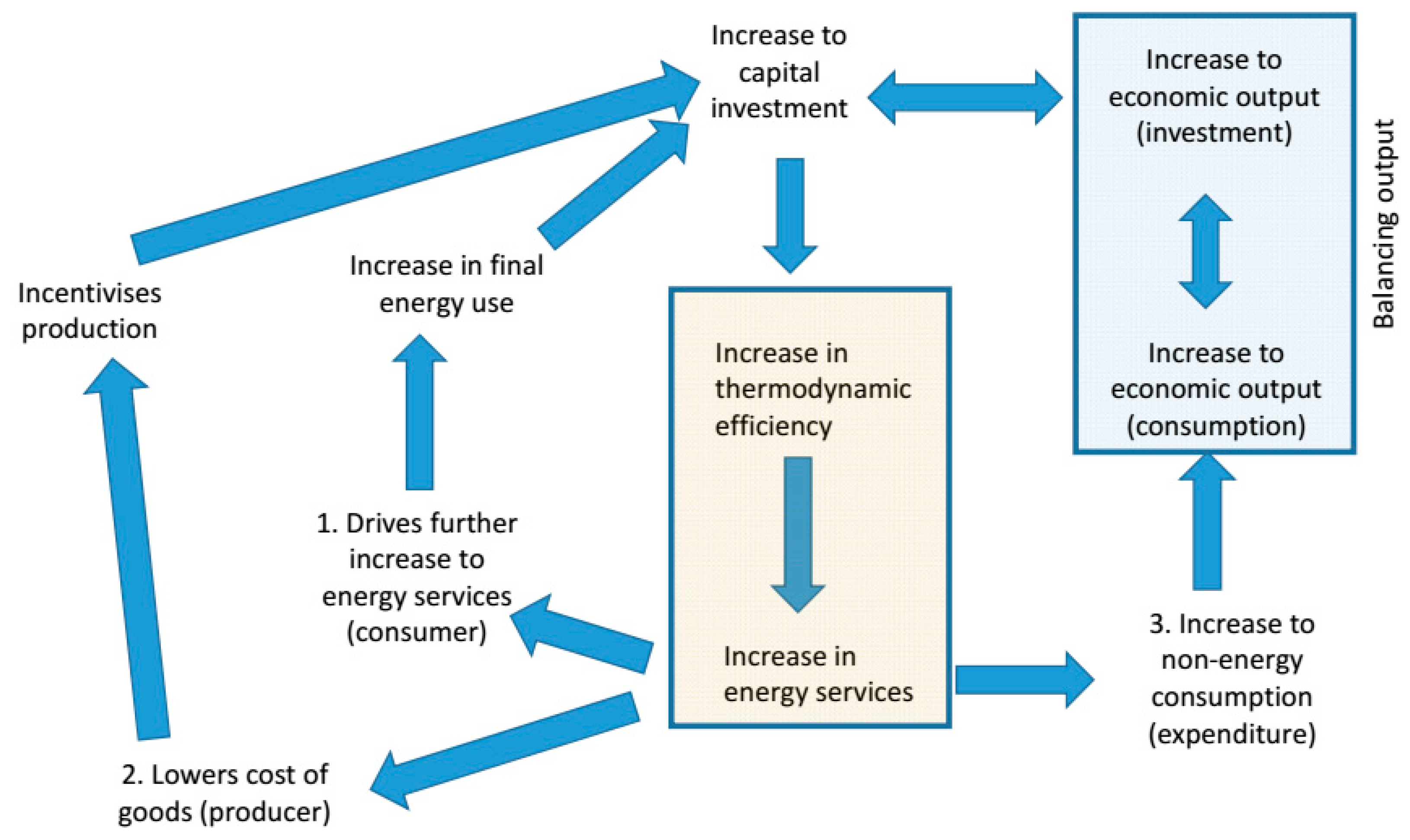
| Variable/Simulation number | Annual contribution to growth of GDP | ||||
|---|---|---|---|---|---|
| 1976–1990 | 1990–2000 | 2000–2013 | 1976–2013 | ||
| 0 | GDP_Basefit growth rate | 2.73% | 2.61% | 1.70% | 2.34% |
| 1 | Thermodynamic efficiency | 0.69% | 0.68% | 0.37% | 0.57% |
| 2 | Final energy | −0.02% | 0.01% | −0.01% | −0.01% |
| 3 | Energy services (useful exergy) | 0.33% | 0.44% | −0.11% | 0.18% |
| 4 | Energy prices | −0.12% | −0.14% | −0.02% | −0.09% |
| 5 | Capital (Investment) | 1.01% | 0.96% | 0.34% | 0.64% |
| 6 | Labour | 0.26% | 0.89% | 0.00% | 0.14% |
© 2018 by the authors. Licensee MDPI, Basel, Switzerland. This article is an open access article distributed under the terms and conditions of the Creative Commons Attribution (CC BY) license (http://creativecommons.org/licenses/by/4.0/).
Share and Cite
Sakai, M.; Brockway, P.E.; Barrett, J.R.; Taylor, P.G. Thermodynamic Efficiency Gains and their Role as a Key ‘Engine of Economic Growth’. Energies 2019, 12, 110. https://doi.org/10.3390/en12010110
Sakai M, Brockway PE, Barrett JR, Taylor PG. Thermodynamic Efficiency Gains and their Role as a Key ‘Engine of Economic Growth’. Energies. 2019; 12(1):110. https://doi.org/10.3390/en12010110
Chicago/Turabian StyleSakai, Marco, Paul E. Brockway, John R. Barrett, and Peter G. Taylor. 2019. "Thermodynamic Efficiency Gains and their Role as a Key ‘Engine of Economic Growth’" Energies 12, no. 1: 110. https://doi.org/10.3390/en12010110
APA StyleSakai, M., Brockway, P. E., Barrett, J. R., & Taylor, P. G. (2019). Thermodynamic Efficiency Gains and their Role as a Key ‘Engine of Economic Growth’. Energies, 12(1), 110. https://doi.org/10.3390/en12010110







